Table of Contents
- What is Broadband?
- What is Good Broadband Speed?
- Does Your Area Need Community Broadband?
- Ready to Bring Broadband Internet to Your Area?
- GrantWorks’ Broadband Services
- Resources
What is Broadband?
Broadband Internet access was once viewed as a luxury but has shifted to a lifeline that empowers communities on multiple fronts. In an increasingly digital world, access to reliable, high-speed Internet is
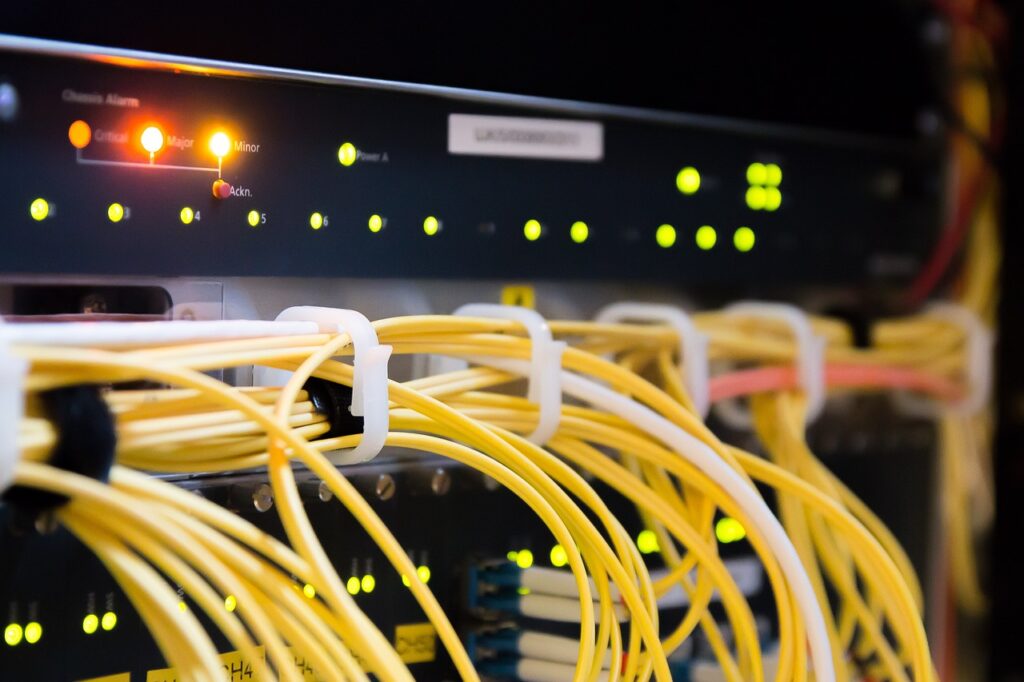
essential for education, healthcare, business, and overall quality of life. It’s a tool that dictates the well-being and progress of areas around the globe, and the unserved or underserved communities are those most in need of community broadband.
This article will define the term “broadband,” the types of broadband connections available, and why broadband Internet is vital for every community’s development.
Defining “Broadband”
The term “broadband” refers to the fast transmission of signals across an area.1 These signals can be used in a range of frequencies and include transferable data like voice, images, videos, and more. The key to broadband, though, is speed, and while there may be an Internet connection, proper broadband connectivity means fast and reliable Internet speed.
Broadband speed is measured by megabits-per-second (Mbps),2 and 1Mbps is one billion bits per second. A megabit should be distinguished from a megabyte – a megabyte is typically used when describing files or storage capacity on a device, and it is made up of 8 megabits.
The Federal Communications Commission (FCC) ruled in 2015 that broadband is defined as a service with download and upload speeds of at least 25/3 megabits per second (Mbps), respectively. With the Broadband Equity, Access, and Deployment (BEAD) Program, introduced in the Infrastructure Investment and Jobs Act of 2021, minimum speeds to be considered “broadband” will increase to at least 100/20 Mbps. Speed also determines if a home, business, or community institution is considered served, underserved, or unserved. When it comes to broadband, unserved is defined as speeds 25/3 Mbps and below, underserved is defined as speeds of 25/3 Mbps – 100/20 Mbps, and served is defined as speeds of 100/20 Mbps and above.
How Does Broadband Work?
The original format of Internet connection was dial-up Internet, a type of Internet access that uses a phone line to connect to a server and transmit data. Over the last 20 years, improvements in technology now provide multiple ways to access the Internet, particularly with higher speeds.
The public Internet is a global system of connected computer networks that provides access to information and allows people to interact with each other worldwide. The connection to the public Internet is provided by a middle-mile provider who brings the connection to the regional area. Local service providers tie into this network and distribute Internet service to each location within the region. Local service can be distributed in multiple ways, including copper, coaxial cable, wireless, and fiber that connects directly to a residence or business. Accessing the Internet from the residence or business provides a connection to the entire network and the public Internet.
What is an ISP?
ISP stands for Internet Service Provider or an organization that provides local services to end users to access the public Internet. ISPs can be structured as a variety of organization types, from commercial entities to non-profit organizations. Some of the most well-known ISPs are companies such as AT&T, Charter Spectrum, Verizon, and Comcast, but residents can also use a local telephone cooperative they subscribe to and receive Internet.
If I Have an Internet Connection, Do I Have Broadband?
The essence of broadband is speed, and while a community can have Internet connectivity, that doesn’t mean a community has a broadband connection if the speeds are slow. Broadband refers to high-speed Internet use, meaning multiple users connecting to the Internet at once without significant delays or loading times.5
What is Good Broadband Speed?
Broadband speed is determined by two different methods of use: download speed and upload speed. Download speed refers to how quickly a user can retrieve data from the Internet, such as downloading a document, photo, or game. Upload speed refers to how quickly a user can put out data on the Internet, such as uploading photos to social media, sending a PDF, or making a video call. Download speed is typically faster than upload speed.3
A good broadband speed may depend on how many devices are connected to the Internet at a given time and how often people are using the Internet in an area. For example, for residential broadband in a two-person household, with a limited number of devices in concurrent use, a speed starting at 25Mbps could be suitable. A larger household of five to seven people, using separate devices, may need a broadband speed of 100Mpbs or more depending on the type of activities and the total devices connected. An area with over ten people all constantly using the Internet, such as an office, each on multiple devices, will likely need a speed of over 1000Mbps.
What Can I Do at Different Broadband Speeds?
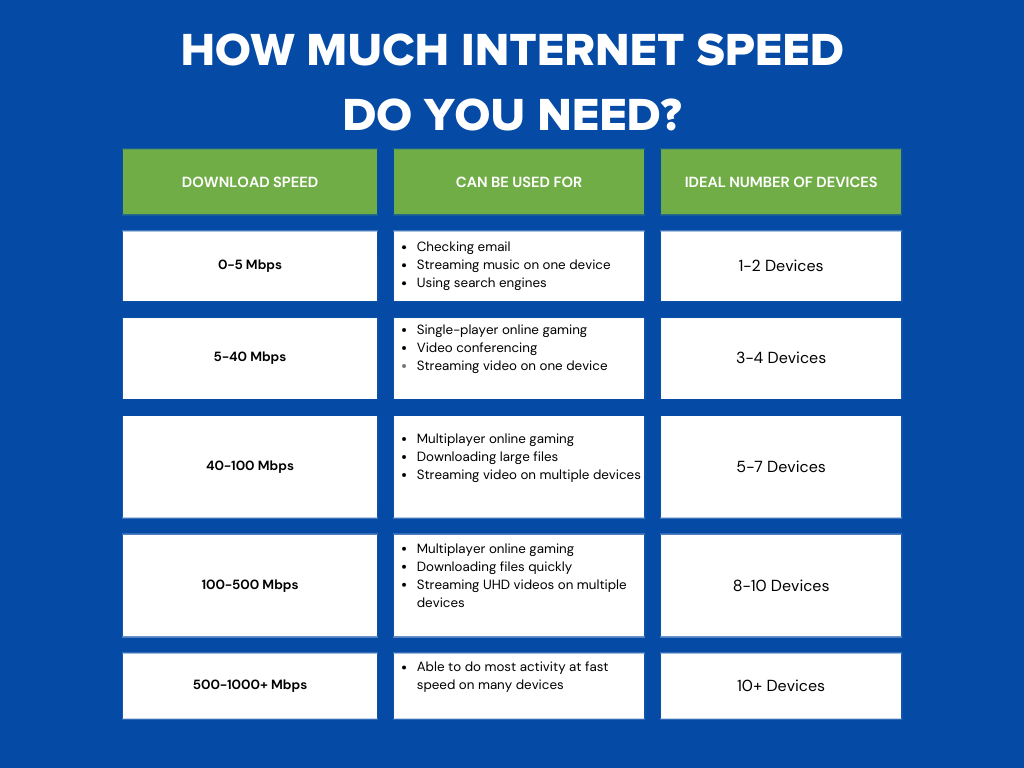
Broadband Speed Test and Instruction
Testing broadband Internet speed can be as simple as typing “broadband speed test” into a search engine. Various sites offer a free speed test on the users current broadband connection without any information required.4 These tests often take less than a minute and measure the speed by accessing nearby test servers and determining how long it would take a server to upload and download data. To receive the most accurate results from an Internet speed test, make sure that all other devices are disconnected from the Internet and only one laptop is connected directly to the modem via ethernet cable. If an ethernet cable or laptop is not readily available, then the test can be run on one device after disconnecting all other devices to get the closest estimation of broadband speed.
Does Your Area Need Community Broadband?
In today’s society, access to broadband Internet is no longer a luxury but a necessity for a community to thrive. Community broadband serves as the backbone of economic, educational, and social progress. Community leaders and key stakeholders play a crucial role in bringing broadband connectivity to their area to ensure community needs are met through this deployment process.
Types of Community Broadband
There are various types of broadband connection, each with its own advantages and disadvantages. Determining the best type of broadband connection for the community will be based on needs, location, and resources.1
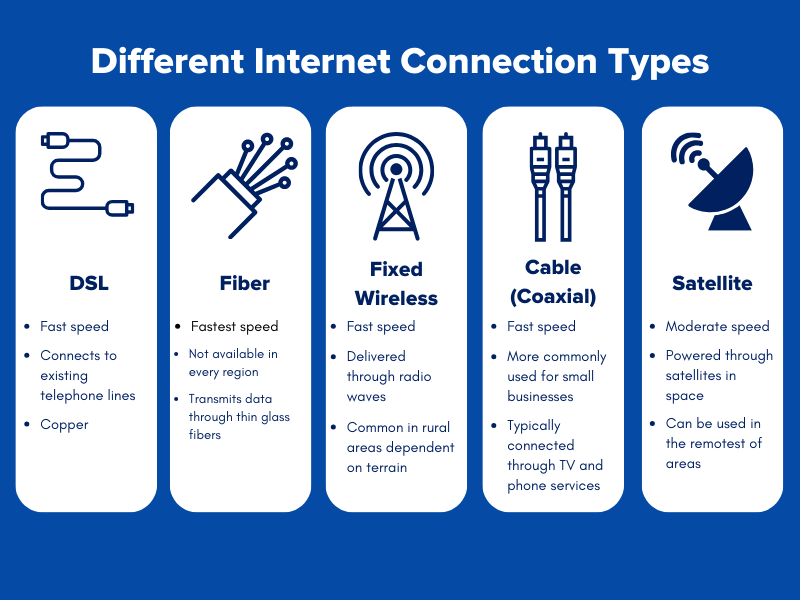
How Community Broadband Helps Rural Areas
Internet connectivity enables businesses to thrive by facilitating e-commerce, digital marketing, and remote work opportunities. It can also help communities expand their overall economic footprint, potentially bringing in new businesses and expanding the workforce opportunities. It empowers educational institutions to provide distance learning, online resources, and research opportunities, thereby helping rural Americans bridge the education gap.
Moreover, community broadband Internet fosters communication, allowing residents in rural areas to stay connected, access telemedicine services, and engage in e-governance initiatives. It is a catalyst for innovation, promoting digital inclusion and providing equal opportunities for all, regardless of geographic location. With the ever-expanding digital landscape, all communities need robust broadband infrastructure to unlock their full potential and participate in the global digital economy.
How Community Broadband Helps Agriculture
Community broadband connectivity can be an essential tool for the business side of modern-day agriculture. Through Internet connectivity, stakeholders in the agriculture industry can remain competitive and operate more efficiently. Broadband access not only speeds up the transfer of data, but it can help automate agriculture processes and improve business outcomes for farmers. Various Internet devices can contribute to automating farming processes such as soil evaluation and reporting leading to higher yield crops and less expense. Some of the most successful farming techniques rely on broadband connections for data collection and analysis.6
What Communities Need Broadband?
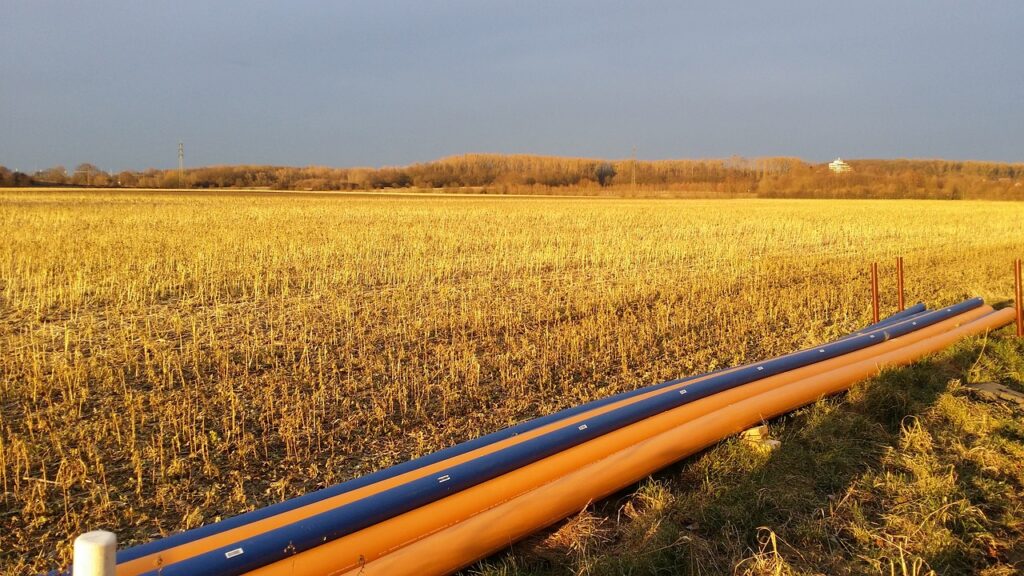
Unserved or underserved communities hoping to develop economic growth need broadband access, and with the ever-growing scope of broadband connection types, any area can gain this connectivity. Rural communities looking to retain both residents and businesses are some of the most apt candidates for broadband connectivity. Rural broadband access can help these areas stay connected, access telehealth appointments, and boost workforce training and job opportunities within a region.
USA Broadband Map
The map of broadband connection across the USA serves as a critical visual representation of the digital landscape, highlighting the disparities and the progress made in nationwide connectivity. While metropolitan areas boast robust broadband infrastructure, rural and underserved regions often face significant challenges in accessing reliable high-speed Internet.7
The FCC’s broadband map showcases the ongoing need for comprehensive efforts to bridge the digital divide, emphasizing the importance of extending community broadband access to all corners of the country. It serves as a baseline for communities to see where connectivity is and is not, what the community’s need are, and provides information for policymakers, Internet service providers, and local leadership to collaborate and understand the expansion needs for broadband connectivity in every community.
Ready to Bring Broadband Internet to Your Area?
Community leaders play a crucial role in advocating for the local implementation of broadband Internet, as it is an indispensable resource for fostering growth and prosperity. By prioritizing community broadband Internet, leaders and key stakeholders demonstrate their commitment to closing the digital divide and promoting equal opportunities for all residents. By championing the cause of broadband Internet, these innovative leaders pave the way for a more inclusive, connected, and digitally empowered future for the community.
What is a Broadband Grant?
Community broadband cannot be established without proper financing, and when private funds fall short of building the infrastructure to all rural areas in a community, the funding can be sought through a broadband grant. There are a variety of federal broadband grant programs that serve as funding opportunities for areas that want to access or improve community broadband in their area. These broadband grant programs are geared to help rural, unserved, and underserved communities that lack proper broadband connectivity and access.
In 2021, President Biden signed the Infrastructure Investment and Jobs Act into law, investing $65 billion to help close the digital divide by providing broadband connectivity to unserved and underserved areas. This law not only laid the groundwork for expanding broadband Internet but allows communities across the country to benefit from job creation, economic and workforce growth, and access to healthcare and educational services.
Some federal grant programs issued by the National Telecommunications and Information Administration (NTIA) include:
- Broadband Equity, Access, and Deployment (BEAD) Program: This program issues approximately $42 billion throughout the USA for broadband deployment, mapping, and adoption projects.8
- Enabling Middle Mile Broadband Infrastructure Program: This program funds a $1 billion project for the construction, improvement, or acquisition of middle-mile infrastructure that reduces the cost of Internet connectivity for underserved communities.8
- Digital Equity Act Programs: This program gives $2.75 billion to establish three grant projects that promote digital inclusion and equity, thereby ensuring that communities have the skill and capacity to reap the benefit of community broadband.8
- American Rescue Plan Act (ARPA): This funding program was administered by the Department of Treasury to provide fast and direct economic assistance – including broadband assistance – for American workers, families, small businesses, and industries.8
Starting the Process for Community Broadband Expansion
When it comes to receiving a broadband grant, community leaders can better understand the needs and priorities within their area through an in-depth stakeholder identification and engagement strategy. This understanding assists in identifying barriers to broadband adoption as well as access and availability needs.
Once the community’s needs and priorities have been identified, leadership can identify funding sources such as NTIA, the United States Department of Agriculture (USDA), or other available state or federal funding programs. From there, community leadership can work with an ISP and data provided by multiple parties to develop a broadband plan. A relationship with an ISP is crucial to a successful project as both parties must work together to make sure all needs are addressed in a manner that serves both the ISP and community’s broadband expansion efforts.
How to Apply for a Broadband Grant
Receiving a broadband grant will vary greatly based on an area’s needs, the program one is applying for, and the resources available. The general process when applying for a broadband grant will include a research and preparation period, time to craft the proposal, and proposal submission that meets the required deadline.
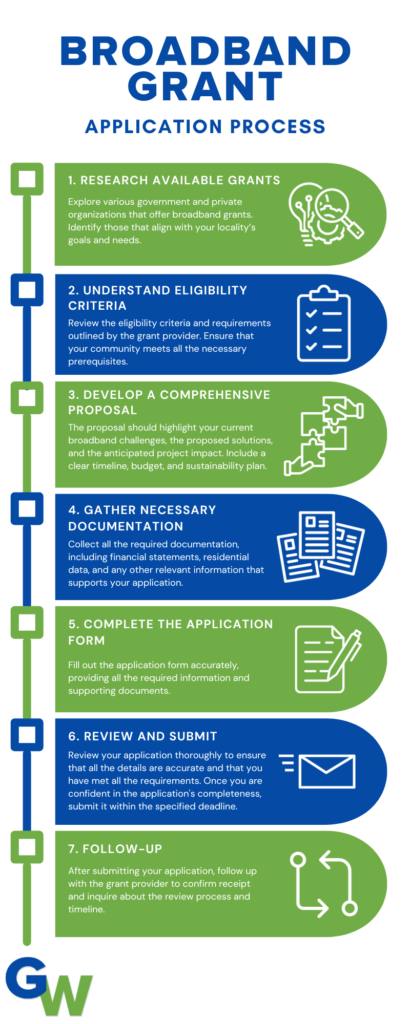
Ultimately, securing a broadband grant can be an arduous and highly competitive process that demands careful planning, meticulous preparation, and a comprehensive understanding of the grant application requirements. The stringent criteria set by funding agencies often require communities to present a detailed and compelling case for the necessity of broadband infrastructure, demonstrating its potential to address specific challenges and uplift the area. Because it is such a strenuous process, working with professional broadband consultants such as GrantWorks can be an extreme advantage for communities in need of broadband connection.
GrantWorks’ Broadband Services
A broadband grant consultant can play a pivotal role in supporting communities to secure essential funding for the development of robust broadband infrastructure. Broadband experts possess a deep understanding of the intricacies of the grant application process and are equipped with the expertise to navigate the complexities of various funding opportunities. Their in-depth knowledge enables them to identify suitable grant programs, craft compelling proposals, and effectively communicate the community’s needs and objectives to potential funding agencies.
With the guidance of a community broadband consultant such as GrantWorks’ Broadband Services Department, communities can access crucial financial resources that pave the way for the implementation of high-speed Internet initiatives, thus fostering economic growth, educational opportunities, and improved access to essential services.
Who We Are
GrantWorks is a purpose-driven company committed to providing high-quality services at an affordable cost. We have successfully assisted over 700 government entities in the design, funding acquisition, and delivery of a wide range of critical projects and programs, many of which center around community broadband. As a trusted community broadband consulting partner, our team works alongside municipal governments, service providers, and state agencies to simplify the complexity of broadband federal funds project management.
What We Do
GrantWorks’ Broadband Services Department offers an advisor and partner with the perfect combination of specialized, in-house grant management, including consulting, research, data analysis, mapping, and project management for all aspects of broadband deployment grants. We’ve managed multiple types of federal funding, including ARPA, FEMA, and DOT, for over 40 years. Our experience includes braiding multiple grants and identifying eligibility and compliance criteria for each funding source.
We’ll help you avoid non-compliance issues that can lead to costly delays, unfavorable public disclosure, notices of regulatory findings, and federal funds’ clawback, and we will take the lead in negotiating technical and operational details with ISPs to ensure optimal outcomes for your community.
Contact GrantWorks today to learn more about our community broadband consulting services.


